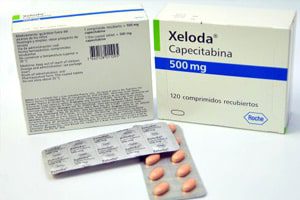
Another medication has been tied to a dangerous, sometimes fatal, skin reaction. This time, an oral cancer medication, Capecitabine (Xeloda), has been tied to Stevens-Johnson Syndrome (SJS) and Toxic Epidermal Necrolysis (TEN). SJS and TEN are typically the result of medication use and are potentially fatal disorders that involve cell death in the skin and […]
 Another medication has been tied to a dangerous, sometimes fatal, skin reaction. This time, an oral cancer medication, Capecitabine (Xeloda), has been tied to Stevens-Johnson Syndrome (SJS) and Toxic Epidermal Necrolysis (TEN).
Another medication has been tied to a dangerous, sometimes fatal, skin reaction. This time, an oral cancer medication, Capecitabine (Xeloda), has been tied to Stevens-Johnson Syndrome (SJS) and Toxic Epidermal Necrolysis (TEN).
SJS and TEN are typically the result of medication use and are potentially fatal disorders that involve cell death in the skin and mucus membranes. SJS blistering usually occurs in the mouth, eyes, and vagina; blistering can spread to internal organs. SJS can also cause patchy areas of rash that ultimately peel off the skin, scarring, and blindness. TEN, an extremely severe form of SJS, occurs when over 30 percent of the body is involved. Both SJS and TEN typically require hospital burn unit treatment.
Xeloda (capecitabine) is an oral medication that is used in the treatment of breast and colorectal cancers, according to MedScape. Drug maker, Hoffmann-La Roche, just reported in an advisory from Health Canada about SJS and TEN reactions seen in patients treated with capecitabine.
Health Canada wrote in a letter to healthcare professionals that “very rare cases of severe cutaneous reactions such as Stevens-Johnson syndrome (SJS) and toxic epidermal necrolysis (TEN), in some cases with fatal outcome, have been reported during treatment with .”according to MedScape.
In September, the U.S. Food and Drug Administration (FDA) granted approval for the first generic version of Xeloda (capecitabine), an oral chemotherapy pill that is used in the treatment of cancer of the colon or rectum (colorectal cancer) that has metastasized (spread) to other parts of the body (become metastatic), as well as metastatic breast cancer. Teva Pharmaceuticals USA gained FDA approval to market generic capecitabine in 150 and 500 milligram strengths.
Capecitabine carries a boxed warning—the agency’s most serious—concerning a potential drug interaction with warfarin that can lead to serious adverse events, according to MedScape. Adverse effects include diarrhea, vomiting, nausea, mouth sores, hand–foot syndrome, fever, and infection.
Meanwhile, the FDA recently issued a Safety Communication over the anti-seizure medication, Onfi (clobazam), and risks of SJS and TEN.
Other drugs that have been tied to SJS and TEN include antibiotics, such as the sulfa drug co-trimoxazole, which is a trimethoprim and sulfamethoxazole combination; other anti-seizure medications, including carbamazepine, phenytoin, phenobarbital, valproic acid, and lamotrigine; pain medications, such as ibuprofen and naproxen; and the antibiotic, Cleocin. This list can change and is not all-inclusive; SJS can be caused by just about any drug and can occur at any time.
The key to stopping SJS is early diagnosis and intervention, which involves stopping the implicated medication that caused the condition. Since the warnings on so many medications are vague, most people do not recognize that SJS has developed when they begin experiencing the syndrome in its earliest stages. Because SJS and its symptoms are not widely known, people may ignore what initially seems to be a minor blister or rash, even though this is a major warning sign for SJS and TEN.
While not every rash or blister is SJS, it is important that consumers understand the risks. Experts advise not using medications unless absolutely necessary, and informing your doctor if you experience flu-like symptoms or a blistering and rash while using any drug.


